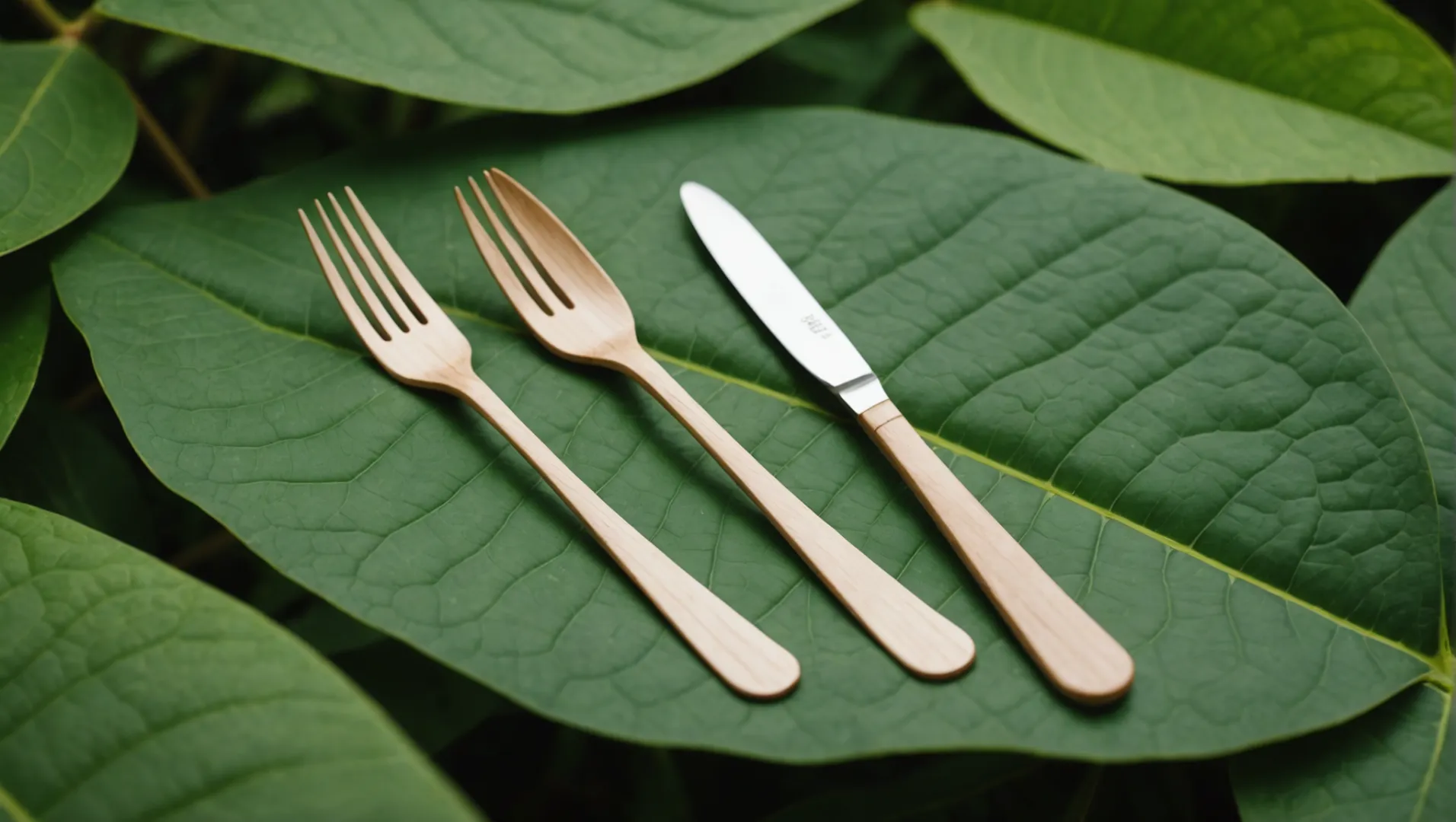
In a time when our planet needs a helping hand, every small choice counts.
To highlight the eco-friendly benefits of disposable wooden cutlery on social media, focus on storytelling that emphasizes its biodegradability, natural aesthetics, and absence of harmful chemicals. Use engaging visuals and real-life testimonials to connect with environmentally conscious consumers.
While these initial tips provide a solid foundation, the effectiveness of your campaign will depend on understanding deeper aspects of wooden cutlery's sustainability and how to communicate them effectively. Dive into the following sections for comprehensive strategies and insights.
Wooden cutlery is biodegradable and compostable.True
Wooden cutlery naturally decomposes in months, unlike plastic, reducing landfill waste.
What Are the Key Eco-Friendly Features of Wooden Cutlery?
Wooden cutlery is gaining popularity as an eco-friendly alternative to plastic, offering a sustainable solution for disposable utensils.
Wooden cutlery boasts eco-friendly features like biodegradability, compostability, and sustainable sourcing, reducing environmental impact significantly. Made from renewable resources and often coated with natural oils, these utensils break down faster than plastic, offering a green alternative for conscious consumers.
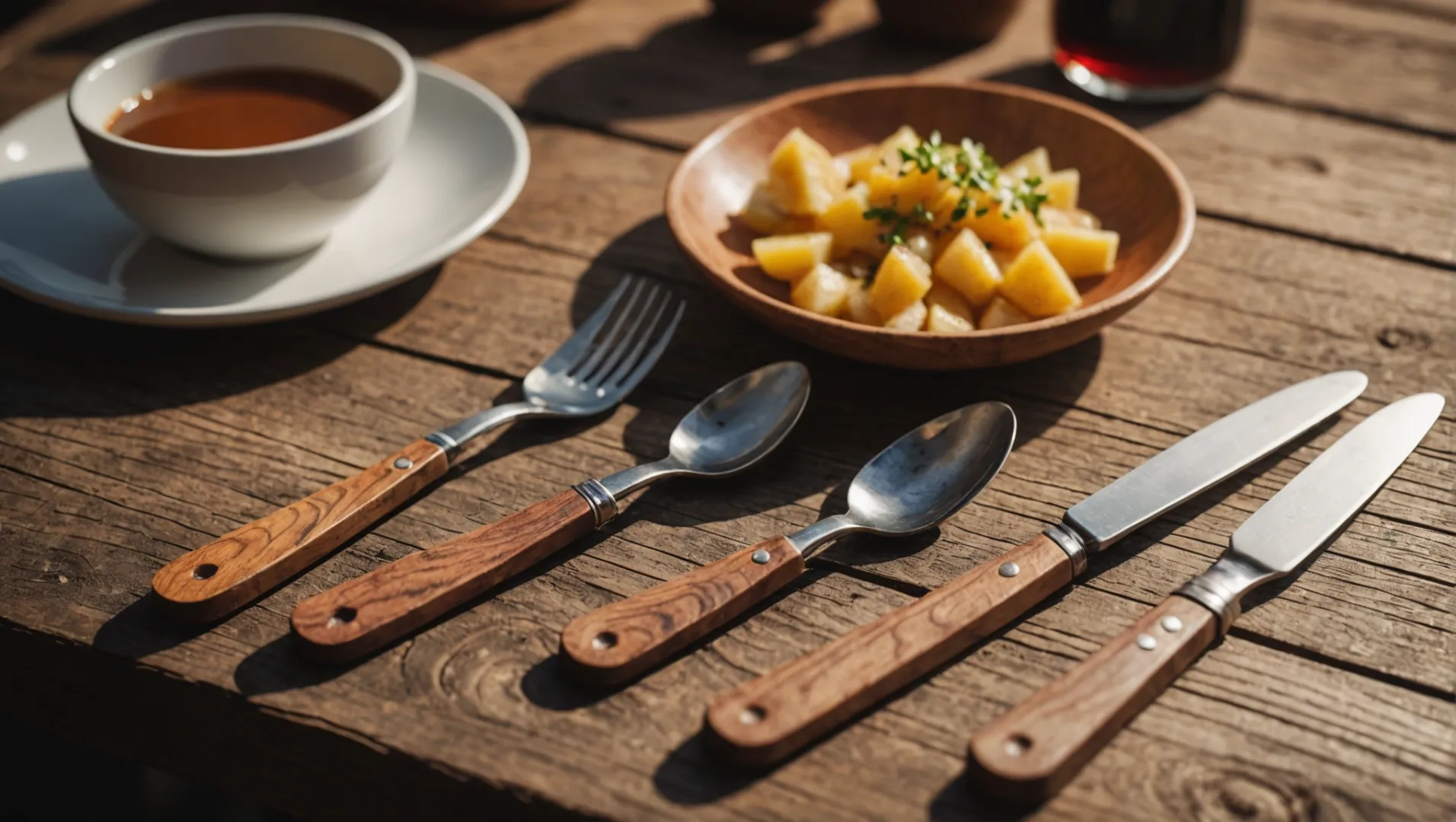
Biodegradability and Compostability
One of the standout eco-friendly features of wooden cutlery is its biodegradability. Unlike plastic, which can persist in the environment for centuries, wooden utensils decompose naturally within months, depending on environmental conditions. This rapid decomposition is further enhanced if the cutlery is composted correctly, turning what was once waste into valuable nutrients for the soil.
- Biodegradable: Breaks down in natural environments
- Compostable: Can enhance soil quality when disposed of properly
These properties significantly reduce the burden on landfills and the environment, making wooden cutlery a sustainable choice for eco-conscious consumers1.
Renewable and Sustainable Sourcing
Wooden cutlery is often made from fast-growing trees such as birch or bamboo, which are renewable resources. Responsible manufacturers ensure that the wood is harvested sustainably, using methods that do not deplete the environment.
Certification from bodies like the FSC (Forest Stewardship Council) can assure consumers that the wood is sourced responsibly, supporting sustainable forestry practices2.
Natural Coatings for Hygiene and Durability
To enhance their durability and usability, wooden utensils are often treated with natural coatings such as beeswax or plant oils. These coatings serve multiple purposes:
- Moisture Resistance: Prevents the wood from absorbing water, which can lead to warping and bacterial growth
- Enhanced Aesthetic: Provides a smooth, polished finish that is pleasing to the touch and eye
Regular reconditioning with oils can maintain these benefits over time, as discussed by experts in eco-friendly manufacturing3.
Reduced Environmental Impact from Production to Disposal
The entire lifecycle of wooden cutlery—from production to disposal—tends to have a lower environmental impact compared to plastic alternatives. The manufacturing process is often less energy-intensive and does not involve harmful chemicals or fossil fuels.
Moreover, when disposed of properly, wooden cutlery does not contribute to pollution or toxic waste. Some manufacturers are even exploring innovative designs that use less material without compromising strength, further minimizing their environmental footprint4.
Wooden cutlery is biodegradable within months.True
Wooden utensils decompose naturally in months, unlike plastics.
Plastic cutlery has a lower environmental impact than wood.False
Plastic requires more energy and chemicals, increasing environmental harm.
How Does Wooden Cutlery Compare to Plastic Alternatives?
As consumers become more eco-conscious, the debate between wooden and plastic cutlery heats up. Which is truly better?
Wooden cutlery offers significant environmental benefits over plastic, being biodegradable and sustainable. While plastic cutlery is durable and convenient, it contributes significantly to pollution. Wooden utensils, however, require proper maintenance to ensure longevity and hygiene, as they can be more porous and susceptible to moisture absorption.
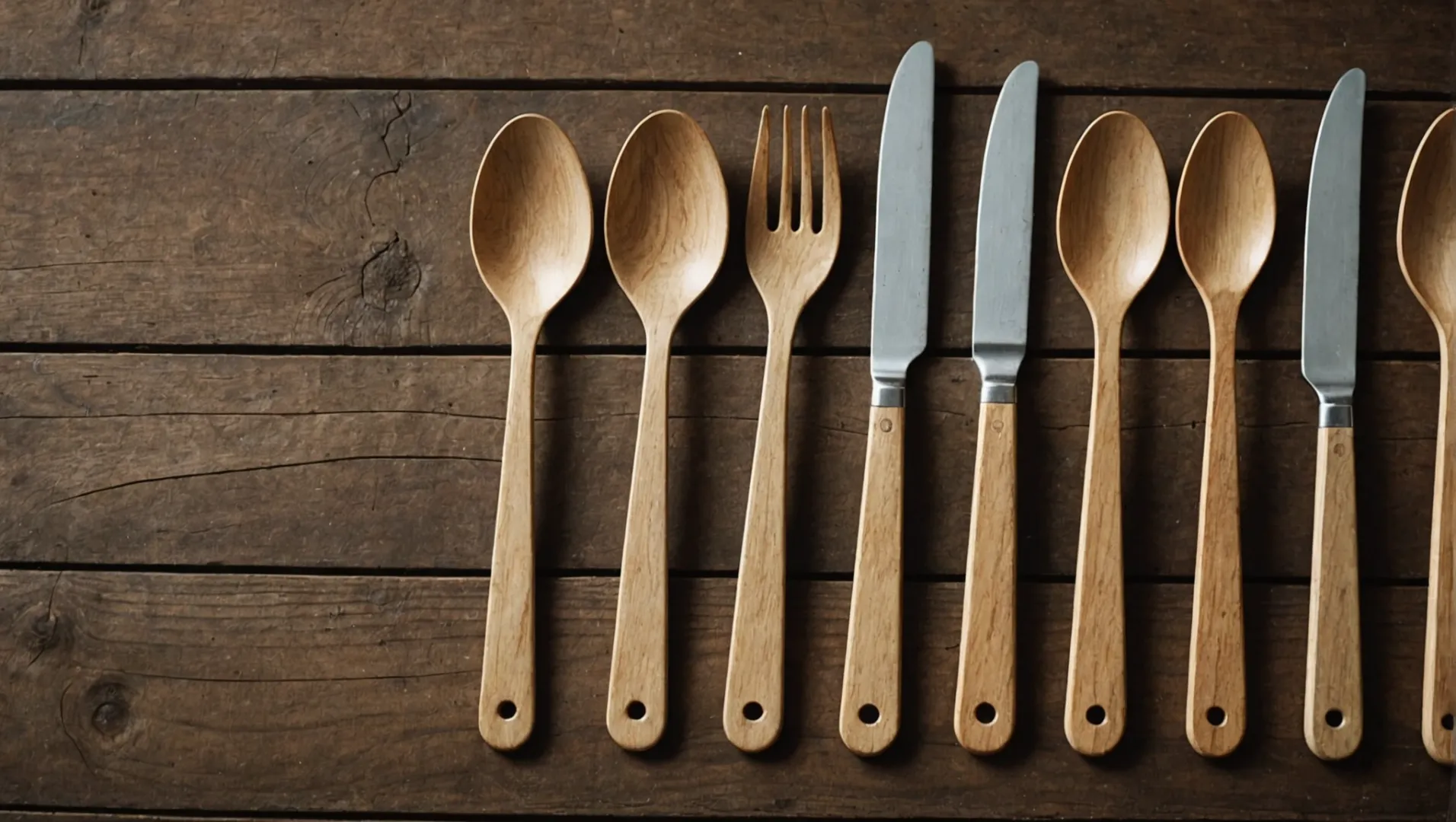
Environmental Impact
When comparing wooden cutlery to plastic alternatives, one of the most significant factors is their impact on the environment. Wooden utensils5 are derived from renewable resources and are biodegradable, decomposing naturally without leaving harmful residues. Conversely, plastic cutlery can take hundreds of years to break down, often resulting in significant environmental pollution.
Furthermore, wooden utensils can often be composted after use, minimizing waste. The sustainability of these products largely depends on responsible sourcing of wood and avoiding toxic chemicals in the finishing process.
Hygiene and Maintenance
While wooden cutlery is generally safe for use, it does present some hygiene challenges due to its porous nature. This porosity can lead to moisture absorption, which may foster bacterial growth if not properly maintained. Manufacturers often apply natural coatings like beeswax or plant oils to counteract this.
For proper care, wooden utensils should be hand-washed with mild soap and warm water, then thoroughly dried. Avoid soaking them, as prolonged exposure to water can lead to swelling or cracking. Regular reconditioning with food-safe oils can help maintain their integrity and prevent microbial contamination.
Durability and Longevity
Plastic cutlery is known for its durability and resistance to various conditions, such as heat and moisture. It provides convenience for single-use purposes but at an environmental cost.
Wooden cutlery, while durable when properly maintained, requires more care. Exposure to high heat or improper cleaning methods can shorten its lifespan. When well-maintained, high-quality wooden utensils can last for many uses, providing an eco-friendly alternative to single-use plastics.
Consumer Preferences and Trends
The growing demand for eco-friendly products has bolstered the popularity of wooden cutlery. Many consumers prefer them for their natural aesthetics and the absence of harmful additives often found in plastics. As awareness of environmental issues rises, consumers are increasingly willing to pay a premium for sustainable options.
Marketing strategies highlighting wooden cutlery's biodegradability and sustainable sourcing resonate well with environmentally conscious consumers. Regions like Europe and North America show significant market growth in this sector.
Certifications and Credibility
Eco-certifications play a crucial role in distinguishing high-quality wooden cutlery from less sustainable options. Certifications such as FSC (Forest Stewardship Council) ensure that wood is sourced from responsibly managed forests. These credentials not only reassure consumers of product safety but also enhance brand credibility in eco-conscious markets.
Companies adopting Life Cycle Analysis (LCA) can further solidify their market position by demonstrating measurable data on energy and resource usage, aligning with stricter regulations against single-use plastics.
In conclusion, while both wooden and plastic cutlery have their place in the market, the former's environmental benefits make it a compelling choice for consumers seeking sustainable solutions. Emphasizing proper care and credible certifications can enhance its appeal over conventional plastic options.
Wooden cutlery is biodegradable and compostable.True
Wooden cutlery decomposes naturally, reducing environmental waste.
Plastic cutlery breaks down faster than wooden cutlery.False
Plastic takes hundreds of years to decompose, unlike wooden cutlery.
Why Is Consumer Education Vital for Promoting Wooden Cutlery?
Understanding wooden cutlery's unique benefits and care needs is crucial for its sustainable use.
Consumer education about wooden cutlery is essential to ensure proper use, longevity, and environmental impact. By informing users about maintenance practices, sustainability benefits, and eco-friendly certifications, manufacturers can enhance user experience and drive demand for wooden cutlery.
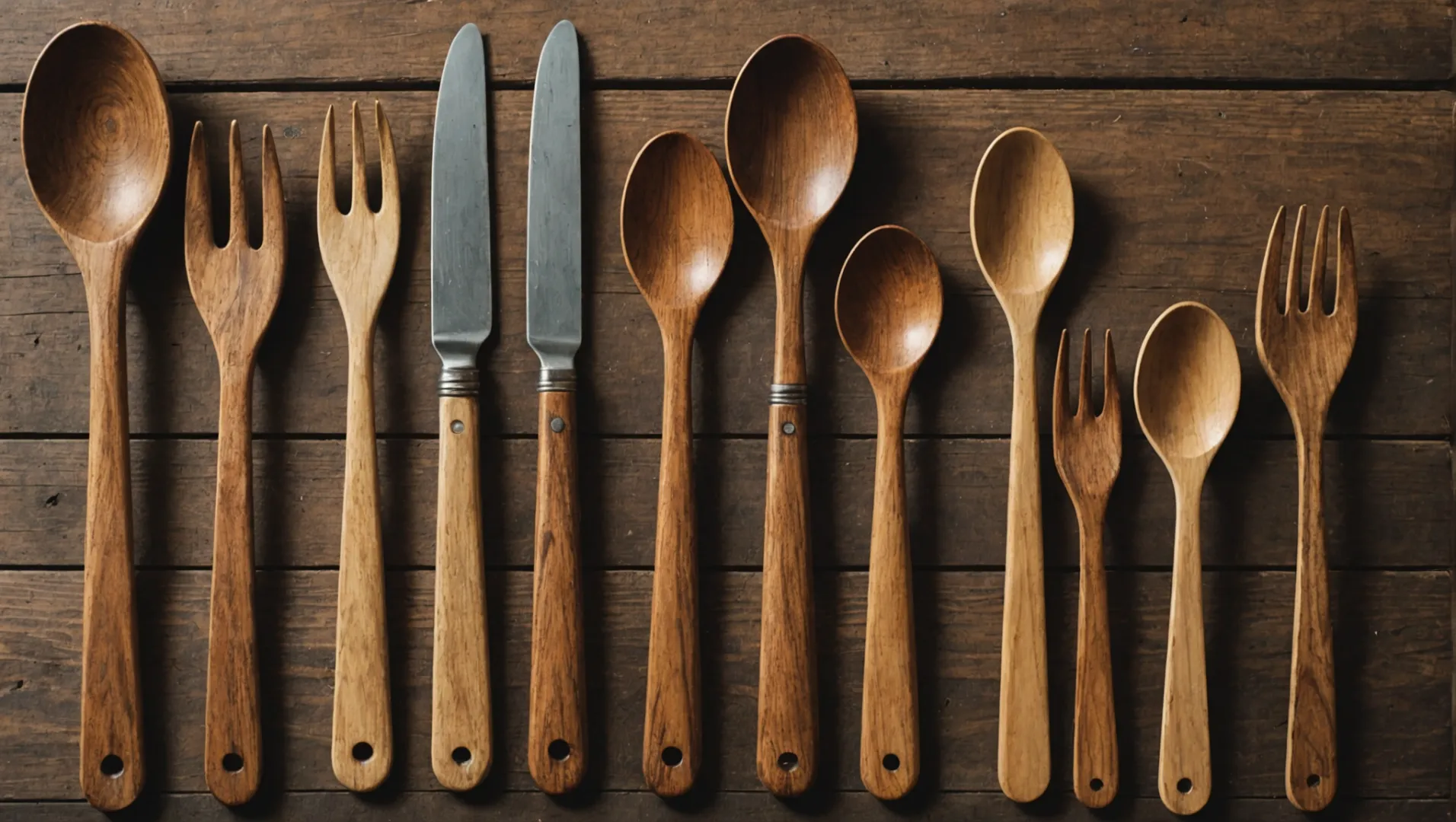
Understanding the Unique Attributes of Wooden Cutlery
Wooden cutlery offers numerous advantages over traditional plastic utensils, including biodegradability, sustainability, and a more natural aesthetic. However, these benefits come with specific requirements for care and maintenance that consumers need to be aware of. Unlike plastic, which is largely maintenance-free, wooden utensils require regular cleaning and oiling to maintain their integrity. Educating consumers on these practices not only prolongs the life of the utensils but also enhances their performance and hygiene.
Maintenance and Longevity of Wooden Cutlery
One of the key aspects of consumer education involves teaching proper cleaning and maintenance techniques. Wooden cutlery should be washed by hand with mild soap and warm water—avoiding prolonged soaking—to prevent warping or cracking. Regular oiling with food-safe oils like coconut or mineral oil helps maintain the finish and prevents drying out or splintering. Providing this information can reassure customers about the long-term value of their purchase.
Environmental Impact and Sustainability
Another critical area of consumer education is raising awareness about the environmental benefits of using wooden cutlery. Unlike plastic, which can persist in the environment for centuries, wooden utensils are biodegradable and compostable. Educating consumers on the responsible sourcing of materials, such as FSC-certified wood, can further highlight the sustainability credentials of wooden cutlery. Offering guidance on composting or recycling options at the end of the product's life can reinforce its eco-friendly attributes.
Certification and Credibility
Certifications play a crucial role in validating the eco-friendliness and safety of wooden cutlery. Educating consumers about relevant certifications such as FDA or LFGB compliance ensures they understand that these products are safe for food contact and sourced sustainably. Moreover, sharing insights about eco-certifications6 helps build trust and credibility among environmentally conscious consumers.
Innovations and Safety Considerations
Innovations in wooden cutlery, such as natural coatings that enhance resistance to moisture and bacteria, should be communicated effectively to consumers. Many manufacturers are investing in coatings that are not only food-safe but also enhance the utensil's durability. Educating consumers about these innovations can alleviate concerns regarding hygiene and usability compared to conventional materials.
The Role of Storytelling in Consumer Education
Storytelling can be a powerful tool in consumer education. Sharing stories about the lifecycle of wooden cutlery—from sustainable sourcing to eco-friendly disposal—can engage consumers emotionally. Highlighting real-life testimonials or case studies where wooden cutlery made a significant positive environmental impact can further bolster its appeal.
Educating consumers on these various facets not only empowers them to make informed choices but also supports the broader goal of sustainability by encouraging the adoption of environmentally friendly alternatives like wooden cutlery.
Wooden cutlery is biodegradable and compostable.True
Wooden utensils decompose naturally, unlike plastic, reducing environmental waste.
Plastic cutlery requires more maintenance than wooden cutlery.False
Plastic utensils are largely maintenance-free, unlike wooden ones needing regular care.
How Can Certification Enhance Your Marketing Strategy?
Incorporating certifications into your marketing strategy can significantly boost consumer trust and market appeal.
Certifications such as FSC or USDA Organic provide assurance of quality and sustainability, enhancing brand credibility. They serve as a competitive advantage by signaling compliance with environmental and safety standards, thereby attracting eco-conscious consumers and differentiating your brand in the marketplace.
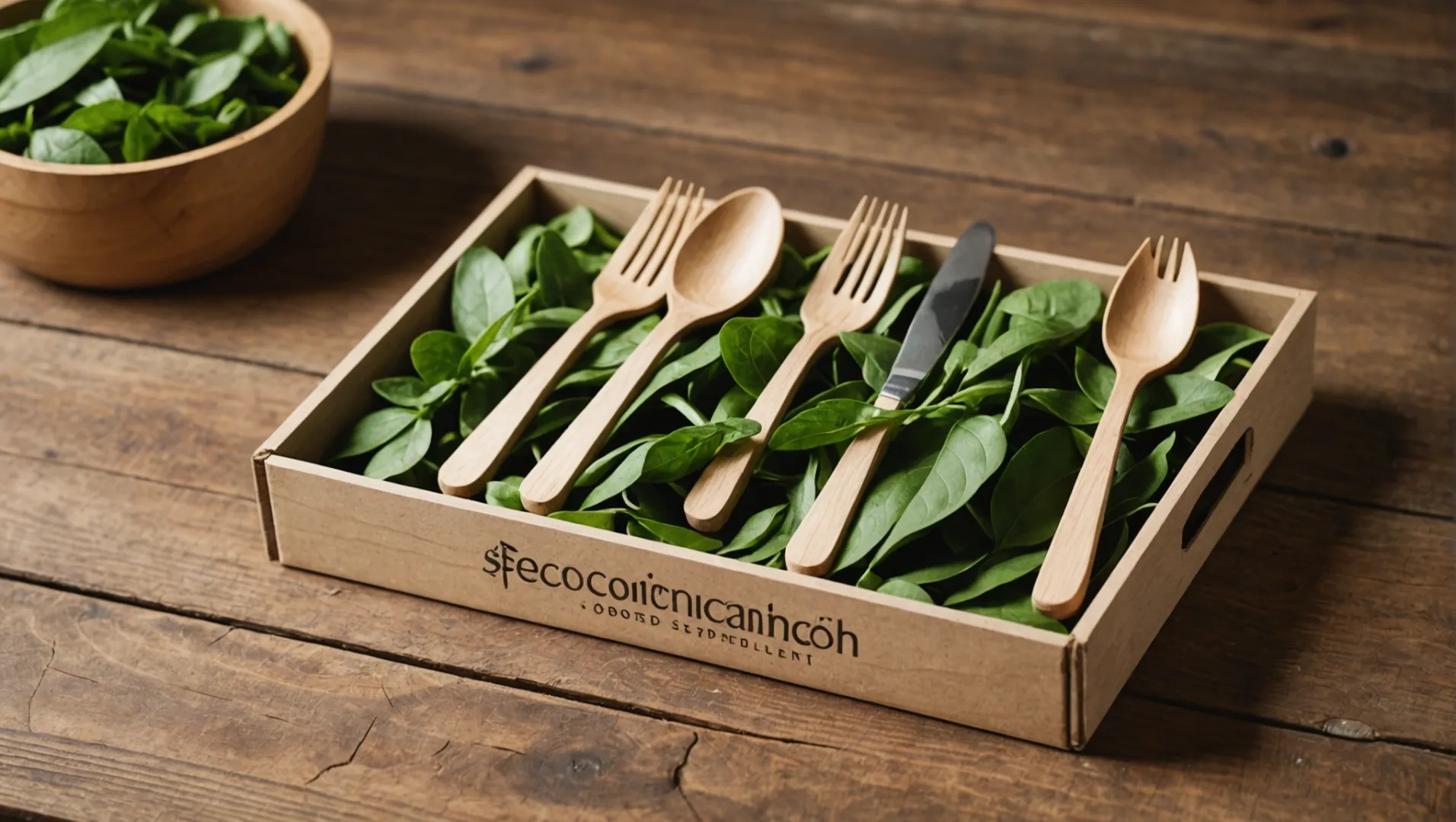
Understanding the Power of Certification
Certifications act as trust signals for consumers. In the realm of eco-friendly products like disposable wooden cutlery, certifications such as Forest Stewardship Council (FSC) or Food and Drug Administration (FDA) approval reassure customers that the products meet specific environmental and safety standards. These certifications can validate your brand's commitment7 to sustainability, which is increasingly important as consumers become more environmentally conscious.
Enhancing Brand Credibility
When you feature certifications prominently in your marketing materials, you provide a tangible proof of quality. For instance, the FSC certification indicates that the wood used is sourced from responsibly managed forests, making your product appealing to environmentally conscious consumers. This can enhance your brand's credibility and encourage customer loyalty.
Competitive Edge in the Market
In a crowded marketplace, standing out is key. Certifications can give you a distinct competitive edge by differentiating your brand from those that do not meet these standards. For example, displaying an FDA certification can assure consumers of product safety, potentially opening doors to new markets with stringent regulatory requirements.
| Certification | Benefits |
|---|---|
| FSC | Ensures sustainable sourcing, appeals to eco-conscious consumers |
| FDA | Guarantees food safety, expands market access |
| USDA Organic | Indicates natural ingredients, attracts health-focused customers |
Marketing Strategies Leveraging Certification
To maximize the impact of certifications, integrate them into your social media campaigns and packaging designs. Use engaging storytelling8 to highlight the journey from forest to table, emphasizing how certifications played a role in ensuring product integrity. Additionally, partner with influencers who value sustainability to amplify your message.
Consumer Trust and Transparency
Transparency about your supply chain and the certifications obtained can further bolster consumer trust. Sharing stories about how your company achieves these standards not only educates but also engages your audience. This transparency can be pivotal in building a lasting relationship with consumers who prioritize sustainability.
FSC certification ensures sustainable sourcing.True
FSC certifies that wood is sourced from responsibly managed forests.
USDA Organic certification guarantees food safety.False
USDA Organic indicates natural ingredients, not food safety.
Conclusion
By embracing sustainability in marketing wooden cutlery, brands can foster trust and loyalty among eco-conscious consumers.
-
Learn how wooden cutlery decomposes quickly and benefits the environment.: The biggest upside of using wood to replace plastic cutlery is that it's a natural, renewable material. This means no fossil-based ingredients are needed to ... ↩
-
Understand how FSC certification ensures sustainable wood sourcing practices.: Sustainable forestry means managing forests in a way that will keep forests healthy and usable for local communities and society as a whole for generations to ... ↩
-
Discover how natural coatings improve hygiene and durability of wooden utensils.: Widely used in this application for centuries, linseed and walnut are natural oils that can create a very durable wood finish, almost like a ... ↩
-
Compare lifecycle impacts of wooden and plastic cutlery on the environment.: When done in an efficient way the total amount of water used in producing wooden utensils is over 99% less than required to produce plastic utensils. This ... ↩
-
Explore why wooden cutlery is more eco-friendly than plastic.: They use less resources, produce less byproducts, and create less waste than single-use plastics. Additionally, when produced with a robust supply chain they ... ↩
-
Understand how certifications ensure safety and sustainability.: The biggest upside of using wood to replace plastic cutlery is that it's a natural, renewable material. This means no fossil-based ingredients are needed to ... ↩
-
Understand why FSC certification adds value to eco-friendly products.: 7 Benefits of Using FSC® Certified Wood Products in Construction · 1. Insulation / Cost Savings · 2. Positive Community Relationships · 3. ↩
-
Learn effective storytelling techniques for promoting sustainability.: Discover how storytelling elevates sustainable marketing, driving change and engaging consumers with examples from leading brands. ↩

